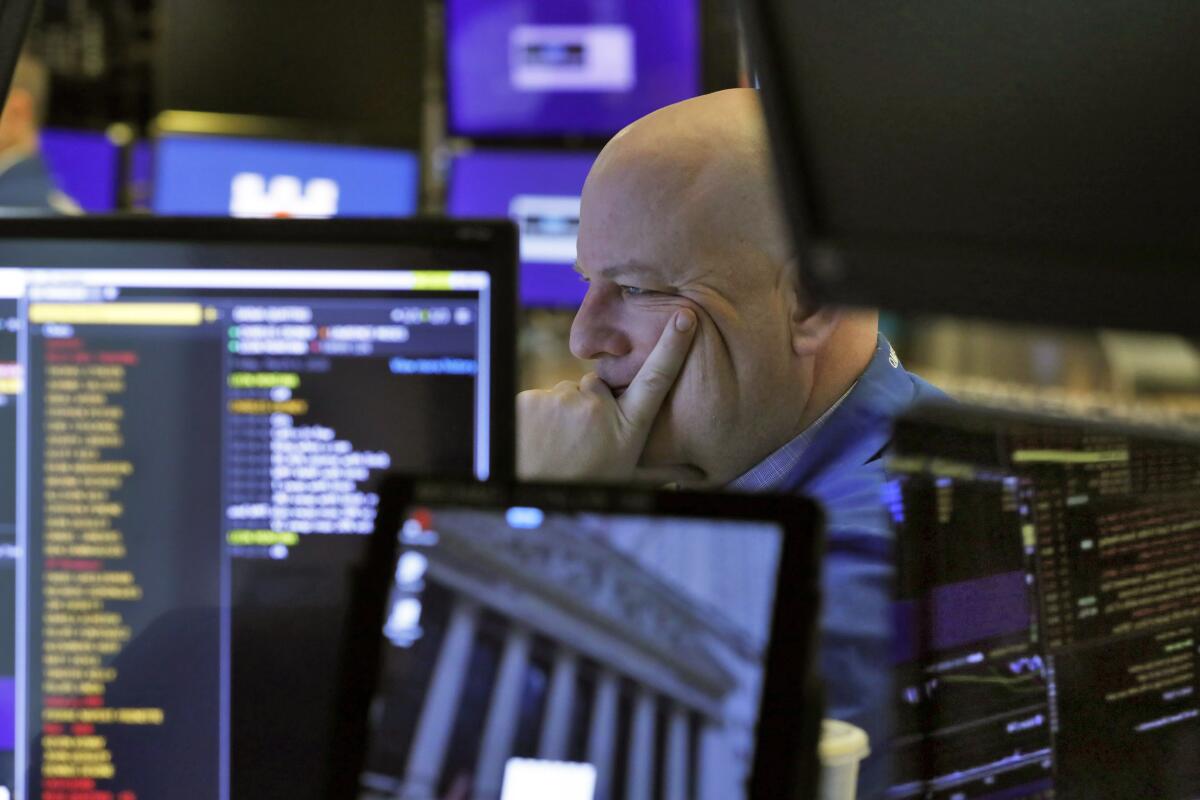Stocks and bond yields finish a wild week with more declines

- Share via
A dizzying, brutal week on Wall Street dropped one last round of harrowing swings on investors Friday.
After skidding sharply through the day as fear pounded markets, U.S. stocks’ and bond yields’ steep drops suddenly eased up in the last hour of trading amid hints from Federal Reserve officials that the Fed may offer more support to the economy.
By the end of trading, the Standard & Poor’s 500 index had more than halved its loss for the day, ending down 1.7%, and even locked in a gain for the week. It’s the latest lurch in a wild ride that has sent stocks flipping between huge gains and losses. Investors are trying to guess how much economic damage the coronavirus outbreak will ultimately inflict, and they’re shifting by the minute as central banks and governments offer stimulus on one end and the number of new infections piles up on the other.
All the uncertainty has left markets churning.
“It’s anyone’s guess at this point why it rallied into the close,” Adam Taback, chief investment officer for Wells Fargo Private Bank, said of the last hour of Friday’s trading.
Treasury yields took another breathtaking drop to record lows.
The 10-year Treasury yield falls when investors are worried about a weaker economy and inflation, and it sank below 0.7% at one point. Earlier this week, it never in history had been below 1%. It was at 1.9% at the start of the year, before the virus fears took hold.
Benchmark U.S. crude tumbled 10.1% — its biggest drop in more than five years — to $41.28 a barrel.
Even a better-than-expected report on U.S. jobs wasn’t enough to pull markets from the undertow. It’s usually the most anticipated piece of economic data each month, but investors looked past February’s solid hiring numbers because they came from before the new coronavirus was spreading quickly in the country.
“The bond market says the monster under the bed is much bigger and scarier than anyone expects right now,” said Ryan Detrick, senior market strategist at LPL Financial.
At the heart of the drops is the fear of the unknown. The virus usually causes only mild to moderate symptoms. But because it’s new, experts aren’t sure how far it will spread and how much damage it will ultimately do, both to people’s health and to the economy.
At first, economists expected the virus to affect mostly China, causing just a short-term disruption. That’s what happened when SARS hit China and Hong Kong in 2003.
But this virus expanded more broadly, the number of infections has topped 100,000 worldwide, and businesses are reporting hits to their earnings. Danger for companies is coming from two sides. On the supply side, for example, Apple has said slowdowns in manufacturing iPhones in China will hurt its sales totals. On the demand side, an airline industry group says the outbreak could lose as much as $113 billion in revenue as people cancel trips.
The S&P 500’s Friday drop was the latest swing in a remarkably turbulent week. The index jumped 4.6% on Monday, fell 2.8% on Tuesday, climbed 4.2% on Wednesday and slid 3.4% on Thursday.
“At this point no one can really explain why the markets behave the way they do and what may be next,” said Ipek Ozkardeskaya, a senior analyst at Swissquote Bank. “The only thing we can say is this high volatility is bad.”
The bond market sounded the alarm on the effects of the virus long before the stock market, and yields fell further Friday.
The Fed surprised the market earlier this week by cutting interest rates by half a percentage point. Investors expect other central banks around the world to follow suit in hopes of supporting markets.
At the same time, doubts are high about how much effect lowering rates can have. Cheaper loans may encourage people and business to make big purchases, but they can’t get quarantined workers back into factories.
A boost for stocks came earlier this week after Congress agreed on an $8.3-billion bill to fight the spread of the coronavirus, a bill President Trump signed Friday. But investors say a slowdown in the economy seems inevitable, and many analysts expect the market’s sharp swings to continue as long as the number of new cases accelerates.
“As the market tries to find its bottom, it’s going to go up and down, up and down, until it has a reason to steadily change in one direction or the other,” said Taback of Wells Fargo Private Bank.
The S&P 500 fell 1.7% on Friday to 2,972.37 points — up 0.6% for the week but down 12.2% from its Feb. 19 all-time high.
The Dow Jones industrial average fell 1% to 25,864.78 points, up 1.8% for the week. The Nasdaq composite fell 1.9% to 8,575.62 points, up 0.1% for the week.
The yield on the 10-year Treasury dropped to 0.77% from 0.92%. It rallied from as low as 0.66% earlier in the day, according to Tradeweb.
Gold rose $4.40 to settle at $1,672.40 an ounce.
More to Read
Inside the business of entertainment
The Wide Shot brings you news, analysis and insights on everything from streaming wars to production — and what it all means for the future.
You may occasionally receive promotional content from the Los Angeles Times.










